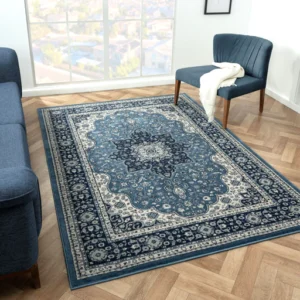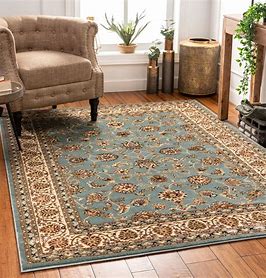Rugs have been an integral part of human history, evolving from simple functional pieces to intricate works of art that grace our homes today. This article delves into the fascinating world of rugs, exploring their rich history, diverse styles, types, shapes, materials, and essential tips for making the right choice when purchasing one.
A Brief History of Rugs:
The history of rugs dates back thousands of years, with evidence suggesting their existence in ancient civilizations such as Egypt, Persia, and China. Initially used for practical purposes like warmth and protection from the cold ground, rugs gradually became expressions of culture, status, and artistic craftsmanship. Nomadic tribes and settled communities alike wove stories into their rugs, creating unique designs that reflected their traditions and beliefs.
When buying rugs, “style” and “type” refer to different aspects of the rug:
Style: The style of a rug refers to its design, pattern, and overall aesthetic. This includes factors such as the rug’s colours, motifs, and decorative elements. Some common rug styles include traditional, modern, transitional, geometric, floral, Oriental, Persian, Moroccan, etc. Style is often a matter of personal preference and should complement the overall décor and theme of the room.
Type: The type of a rug refers to its construction, materials, and how it’s made. This encompasses factors such as the rug’s pile (e.g., flatweave, low pile, high pile), weaving technique (e.g., hand-knotted, hand-tufted, machine-made), and materials used (e.g., wool, silk, cotton, synthetic fibres). The type of rug can significantly impact its durability, texture, feel, and maintenance requirements. For example, hand-knotted rugs are generally considered to be of higher quality and durability compared to machine-made rugs.
The Styles of Rugs:

Traditional Rugs: A traditional rug is a handcrafted floor covering with intricate patterns and vibrant colours, made from natural fibres like wool or silk using age-old techniques such as hand-knotting or weaving.

Modern Rugs: A modern rug is a contemporary floor covering featuring innovative designs, bold colours, and often geometric patterns. It’s typically made using modern manufacturing techniques and materials like synthetic fibres or blends, though natural fibres can also be used. Modern rugs are known for their sleek, minimalist aesthetic and versatility in complementing contemporary interior designs.

Transitional Rugs: A transitional rug blends elements of traditional and modern styles, often featuring a mix of classic patterns with contemporary colours and design elements. These rugs serve as a bridge between traditional and modern décor, offering versatility and flexibility in interior design schemes. They can incorporate both natural and synthetic fibres and come in various sizes, shapes, and patterns to suit different tastes and spaces. Transitional rugs are prized for their ability to harmonize diverse décor elements and bring balance to a room.

Geometric Rugs: A geometric rug is a contemporary floor covering characterized by bold, repetitive patterns and shapes such as squares, rectangles, triangles, or circles. These rugs often feature clean lines and symmetrical designs, creating a visually striking focal point in a room. Geometric rugs can be found in a variety of colours and materials, offering a modern and dynamic addition to interior spaces. They are popular for adding a sense of structure and visual interest to both traditional and contemporary décor styles.

Floral Rugs: Floral rugs are floor coverings adorned with intricate floral patterns and motifs. These rugs often feature a variety of flowers, leaves, and vines, intricately woven or printed onto the rug’s surface. Floral rugs come in a range of styles, from traditional to modern, and can be found in various colours and sizes to suit different interior designs. They add a touch of natural beauty and elegance to living spaces, making them popular choices for enhancing the ambiance of a room.

Persian Rugs: Persian rugs are exquisite handcrafted floor coverings originating from Iran (formerly Persia). These rugs are renowned for their intricate designs, rich colours, and exceptional craftsmanship. They often feature elaborate patterns such as floral motifs, geometric shapes, or intricate medallions, woven with precision using traditional techniques passed down through generations. Persian rugs are typically made from high-quality wool or silk fibres, creating luxurious textures and durability. They serve as timeless and elegant pieces of art that add warmth, beauty, and cultural heritage to any interior space.

Oriental Rugs: Oriental rugs are intricate handcrafted floor coverings originating from various countries in Asia, including but not limited to Iran, Turkey, India, China, and Pakistan. These rugs are renowned for their elaborate designs, rich colours, and fine craftsmanship. Oriental rugs often feature intricate motifs, geometric patterns, and ornate borders, meticulously woven using traditional techniques passed down through generations. They are typically made from high-quality wool or silk fibres, offering both durability and luxurious texture. Oriental rugs serve as timeless and elegant additions to interior spaces, adding warmth, character, and cultural heritage to any room.

Moroccan Rugs: Moroccan rugs are handcrafted floor coverings originating from the North African country of Morocco. These rugs are known for their distinctive geometric patterns, bold colours, and plush textures. They are traditionally handwoven by Berber artisans using techniques passed down through generations. Moroccan rugs often feature intricate designs such as diamonds, triangles, or zigzags, woven into a dense pile of wool or a combination of wool and other fibres like cotton or silk. They serve as stylish and versatile additions to interior spaces, adding warmth, texture, and a touch of exotic flair to any room.
The Types of Rugs:

Area Rugs: Area rugs are versatile floor coverings that add style, warmth, and comfort to a space without covering the entire floor. They come in various shapes, sizes, colours, and materials, offering endless options to complement different interior designs. Area rugs can be used to define seating areas, add visual interest, protect flooring, or provide a soft surface underfoot. They are typically placed in living rooms, dining areas, bedrooms, or hallways to enhance the overall aesthetic and functionality of a room.

Runner Rugs: Runner rugs are long, narrow floor coverings designed to add style and functionality to hallways, entryways, or narrow spaces. They come in various lengths and widths, typically longer and narrower than standard area rugs. Runner rugs are often used to protect high-traffic areas, provide a soft surface underfoot, or add visual interest to otherwise overlooked spaces. They come in a wide range of styles, colours, and patterns, allowing them to complement various interior designs while serving a practical purpose in the home.

Shag Rugs: A shag rug is a plush and luxurious floor covering characterized by its long, fluffy pile. These rugs are known for their soft texture and cosy feel underfoot, making them popular choices for adding comfort and warmth to living spaces. Shag rugs come in various colours and materials, with wool and synthetic fibres being common options. They often feature a casual and relaxed aesthetic, adding a touch of comfort and style to any room.
The Shapes of Rugs:
Rugs come in various shapes to suit different room layouts and preferences. Common shapes include rectangular, square, round, and oval. Choosing the right shape depends on factors such as the room’s dimensions, furniture placement, and overall design aesthetic.
In addition to traditional shapes, consider these unique shapes:

Hexagonal Rugs: Perfect for adding a modern touch to a room, hexagonal rugs are unconventional and can be used to create interesting visual effects, especially in contemporary and eclectic interiors.

Scalloped Rugs: Featuring scalloped edges, these rugs bring a touch of whimsy and elegance to a space. They work well in areas where a softer, more feminine aesthetic is desired.
The Materials Rugs Can Be Made From:
The material of a rug greatly influences its appearance, durability, and feel. Common rug materials include:
Wool: Durable and naturally resistant to stains, wool is a popular choice for its soft texture and ability to retain vibrant colours.
Silk: Luxurious and delicate, silk rugs often feature intricate designs and a lustrous finish.
Cotton: Lightweight and affordable, cotton rugs are easy to clean and suitable for casual spaces.
Jute and Sisal: Natural fibres like jute and sisal provide a rustic, eco-friendly option with a textured surface.
The Dos and Don’ts When Buying Rugs:
Do:
Consider the Room: Choose a rug that complements the room’s colour scheme, furniture, and overall design.
Size Matters: Ensure the rug’s size is appropriate for the space, allowing for a balanced and harmonious look.
Think About Functionality: Select a rug based on the room’s purpose – a durable and easy-to-clean rug is ideal for high-traffic areas.
Don’t:
Neglect Quality: Invest in a quality rug that will withstand wear and tear, as a well-made rug can last for generations.
Overlook Maintenance: Consider the ease of cleaning and maintenance before making a purchase, especially in households with pets or children.
Forget About Comfort: While aesthetics are crucial, don’t compromise on comfort. Choose a rug that feels good underfoot and enhances the overall cosiness of the space.
Rugs have transcended their functional origins to become an integral part of interior design, offering a unique way to express personal style and cultural heritage. With a rich history, diverse styles, types, shapes, and materials, the world of rugs is a tapestry of artistry waiting to be explored. By keeping in mind the dos and don’ts when buying rugs, individuals can bring these timeless pieces into their homes, adding warmth, character, and visual appeal to their living spaces.




